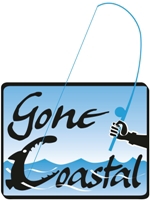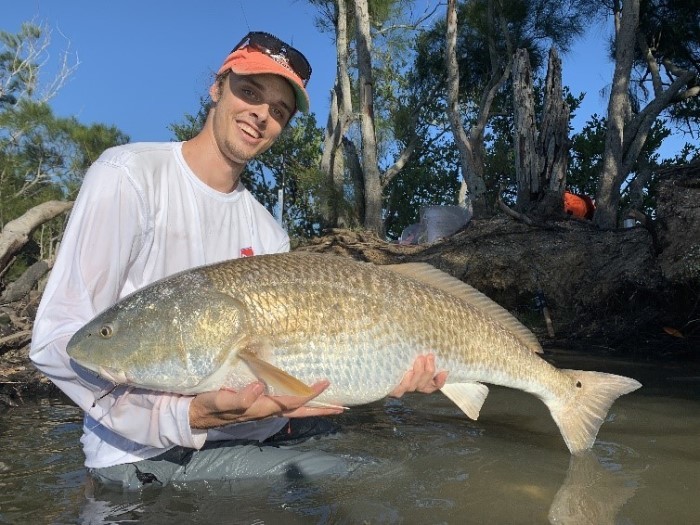Leading the charge on handling bull redfish
Florida Fish & Wildlife Conservation Commission sent this bulletin at 12/28/2021 11:05 AM EST
(Having trouble viewing this email? View it as a Web page.)

By Jill Christoferson
Suggested Tweet: Leading the charge on handling bull #redfish @MyFWC: [[VIEW_THESE_URLS]] #Florida #fishing
Leading the charge on handling bull redfish
Everyone likes catching big fish. They put up a great fight, come with serious bragging rights, look super cool in a profile pic and, if harvested, they can feed lots of friends and family. Bull redfish are just one example of a popular saltwater species that have anglers chasing “the big one” for their next fish tale. While there is no doubt that monster reds have rightfully earned their place in the big leagues, any redfish angler worth their salt will tell you that an important part of any trip catching bull reds is the release.
Florida regulations require that redfish over 27 inches be released. The intent of this regulation is to protect larger fish (redfish don’t usually spawn until they get larger than 27 inches). Larger fish also produce higher quality and larger numbers of eggs and sperm.
This is why doing everything you can to help larger fish survive after release is so important. It’s also important to remember that just because a fish swims away doesn’t always mean it will survive. Taking steps to ensure that the fish is in good condition upon release means it has a better chance of surviving long-term to the next spawn. Use these tips to help your next bull red, or any other fish you release, survive to fight another day:
-
Keep large fish in the water to reduce stress or injury to the fish.
-
Use tackle that is large enough to bring the species you are targeting in quickly, reducing the chance of exhaustion.
-
Always revive fish showing signs of exhaustion by allowing a consistent flow of water through the mouth and over the gills. Use a “figure eight motion” if you are fishing from a stationary location.
-
Do not gaff a fish unless you intend to harvest it.
-
Keep fingers out of the eyes and gills.
-
Use a descending device or venting tool on fish with signs of barotrauma (bloated belly, stomach projecting from the mouth, protruding intestines, bulging eyes).
If you must remove fish from the water:
-
Get them back in the water as soon as possible.
-
Always hold them horizontally and support their weight with two hands.
-
Use wet hands when handling, never a towel or other cloth that can remove their protective slime.
-
Do not drag them over rocks, the gunnel of a boat, the side of a dock or pier, or any other rough surface.
Fishing from bridges or piers:
-
Only bring fish onto the pier or bridge if you intend to harvest.
-
Only target large fish from bridges or piers if you have specialized gear (pier nets or slings) to support their full body, bringing up large fish without proper gear or allowing them to freefall large distances can cause injury and increase mortality.
-
If you cannot properly lift the fish, cut the line as close to the fish as possible before releasing it back into the water. (This may mean walking this fish to the shore if fishing from a pier.)
Other tips:
-
Correctly using a dehooking tool can help you quickly and easily remove hooks.
-
Use single circle hooks that are non-stainless steel, non-offset and barbless.
-
Do not fish when large predatory fish or sharks are in the area. If they show up, move to another fishing location.
-
Encourage other anglers to adopt these practices too. Learn more at MyFWC.com/FishHandling.
So next time you’re out on the water and catch a bull red or any other big fish for your next great fish tale, remember that landing is only half the battle and a successful release ensures more monsters for generations to come.
Have a question about marine fisheries regulations, improving recreational data, catch and release or more? We are here for you. Send your questions, photos and fishing tales to Saltwater@MyFWC.com. Make sure your image meets our photo requirements and handling guidelines by visiting MyFWC.com/Marine and clicking on “Submit a Photograph.” Learn how to submit your catches and get rewarded through our Saltwater Angler Recognition Programs at CatchaFloridaMemory.com.

Photo courtesy of Pierce Sanders
The quarterly Gone Coastal column is one of many ways that the Florida Fish and Wildlife Conservation Commission (FWC) Division of Marine Fisheries Management is helping recreational anglers understand complex saltwater regulations and learn more about saltwater fishing opportunities and issues in Florida. We are also available to answer questions by phone or email anytime, and we would love the opportunity to share information through in-person presentations with recreational or commercial fishing organizations. To contact the FWC’s Regulatory Outreach subsection, call 850-487-0554 or email Saltwater@MyFWC.com.

